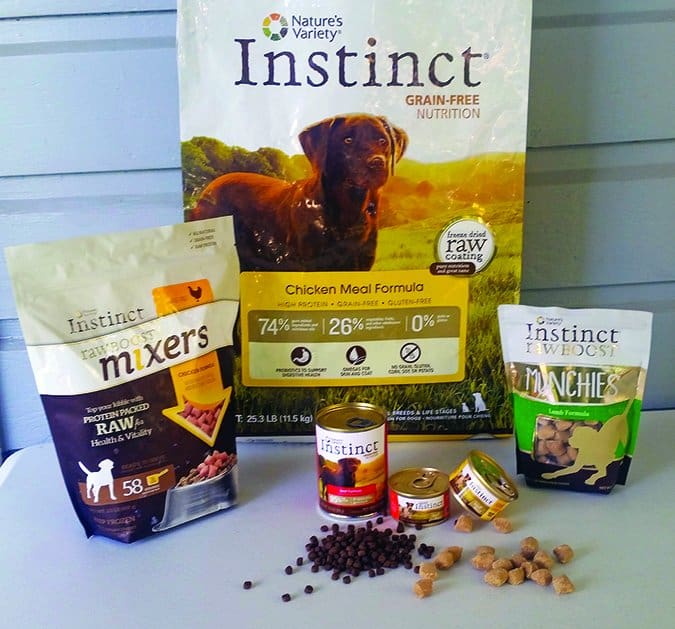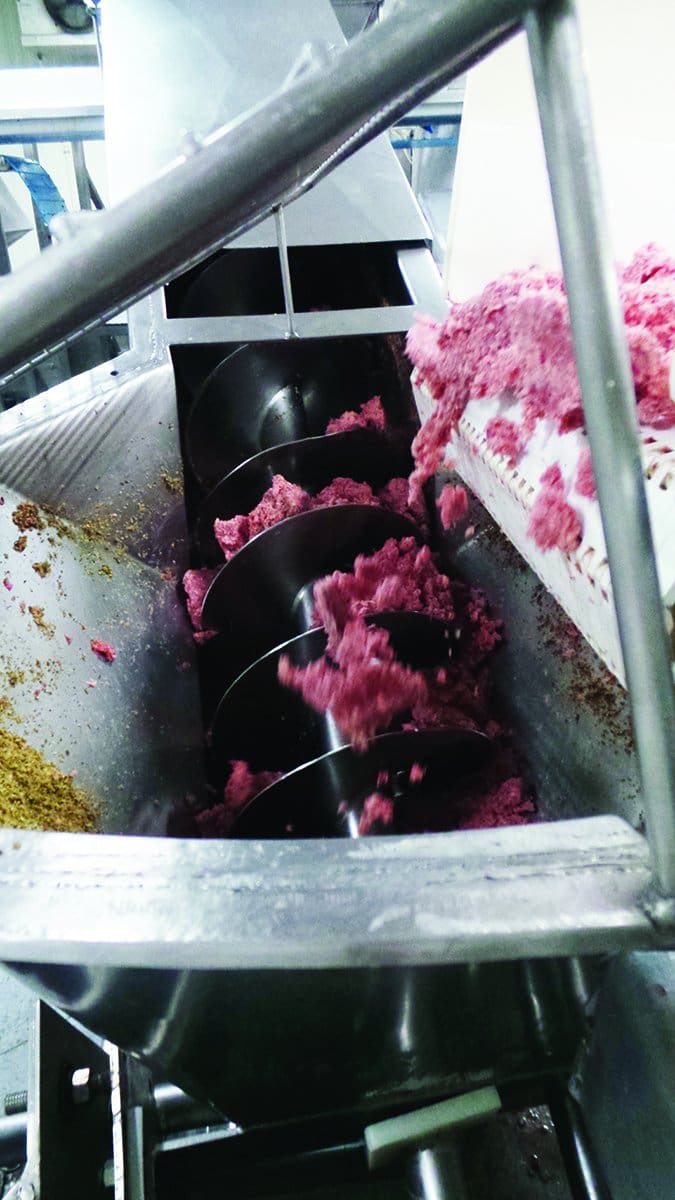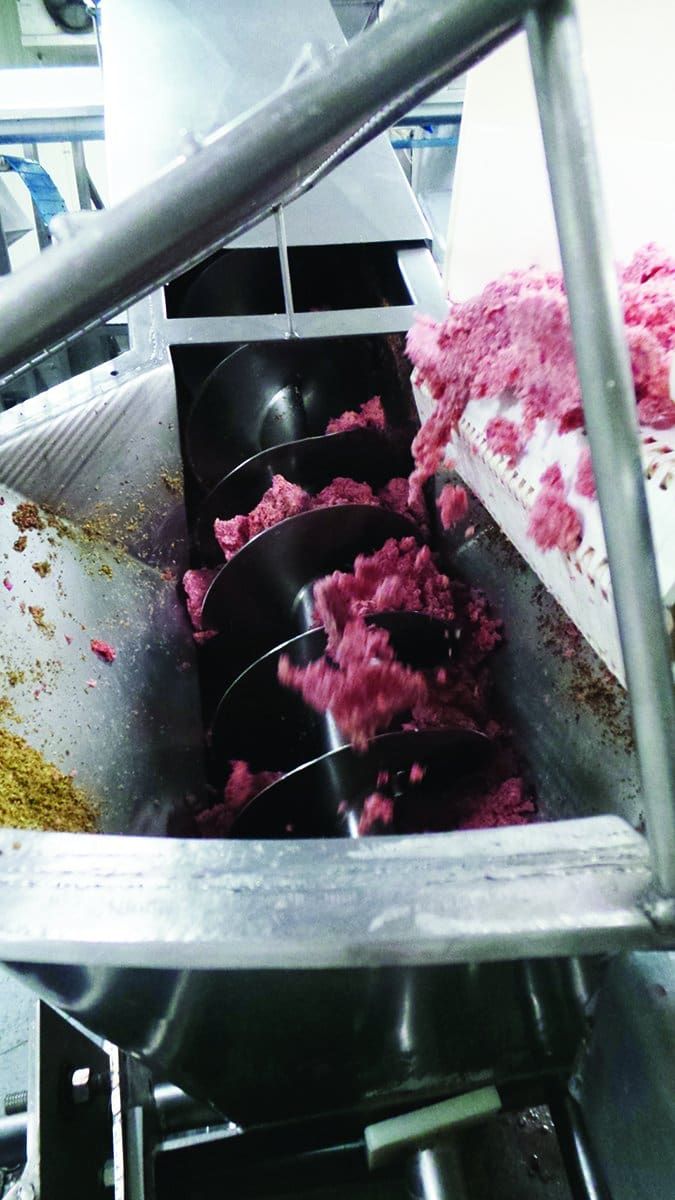Nature’s Variety was founded in 2001 by Bob Milligan, a Nebraska businessman with experience in pork production and pet food manufacturing. As indicated by the name, he founded the company on the principle that dogs (and cats) should be given a variety of dietary options, both in terms of ingredients (chicken, beef, lamb, pork, etc.) and in the very form of food they are given (kibble, canned, etc.). While many companies offer a dry and a canned form of their products, Milligan was ahead of the curve in adding frozen raw diets to the Nature’s Variety offerings from the get-go. To ensure that consumers were well educated about these unique products and the concept of “rotational feeding” – very new at the time – Nature’s Variety products were sold only in independent pet supply stores when they were introduced to the retail market in 2002.

The company has experienced continual growth since then, to the extent that a complete review of the company’s offerings is a monster of a task because of the sheer variety (sorry about the pun) and number of skus (stock-keeping units) offered by the company. And it’s not a sitting target! At press time, the company was announcing a number of changes to its lineups.
Nature’s Variety offers two distinctly different lines of food: Instinct and Prairie. True to the promise of “variety” present in the company’s name, each line offers several forms of food – which may include kibble, canned, raw frozen, dehydrated raw, and/or treats – that are all formulated in accordance with the precepts of that line.
INSTINCT
All of the products in all of the Nature’s Variety Instinct lines are grain-free and contain raw meats – some, more raw than others.
Raw Frozen Diets
Nature’s Variety’s frozen raw diets are the foundation of the Instinct line. Eight different formulas are available: beef, chicken, duck, lamb, rabbit, tuna, turkey, and venison. Three of the formulas (beef, lamb, turkey) contain protein from only the species of animal in the name. The rest contain various proteins from a second species: The chicken products also contain turkey heart and liver; the duck products also contain turkey heart, liver, and ground bone; the rabbit products also contain pork liver, heart, fat, and ground bone; the tuna products also contain chicken meat, ground bone, and liver; and the venison products also contain lamb ground bone, kidney, heart, and liver.)
All of these diets are comprised of 95 percent animal ingredients: named meats, organs, and ground bone. The rest is comprised of vegetables, fruit, and other foods, including pumpkin seeds, flaxseed, yeast culture, Montmorillonite clay (a natural source of trace minerals), salt, cod liver oil, dried kelp, and dried chicory root.
These foods do not contain vitamin/mineral premixes.
All of the products contain a minimum of 14 or 15 percent protein (depending on the formula) and a minimum of 8 or 9 percent fat on an as-fed basis. (See chart below.)
These frozen raw formulas are offered in four different forms: “raw bites” (grape-sized nuggets); “raw medallions” (1-ounce, coin-shaped); “raw patties” (8-ounce, hamburger-patty-shaped); and a 5-pound “chub” (a solid tube of food). All eight formulas are available in the raw patties; seven formulas are offered in “bite” form; six in the medallions; and only two in the chubs. The ingredients for each variety are the same, no matter the form it comes in; in other words, the Chicken variety has the same ingredients whether it’s in the bites, medallions, patties, or chub form.
Each of the formulas provides “complete and balanced” nutrition for dogs of all life stages. Each of the products carries the statement that they are “comparable in nutritional adequacy to a product which has been substantiated using AAFCO feeding tests.” This statement should alert the consumer that the product has qualified as “complete and balanced” by virtue of what’s known as the AAFCO “family rule.” For an explanation of the strengths and weaknesses of this qualification, see “Complete and Balanced Dog Food.”
Though it is under no obligation to disclose which product was actually subjected to feeding trials – the “lead product” – Nature’s Variety disclosed to WDJ that the company subjected its Raw Chicken diet to feeding trials between 2007 and 2010; that’s the lead product. The company’s other raw frozen diets have met the criteria for inclusion in that product’s “family.”
As of press time, complete nutrient analyses for these or the other Nature’s Variety products are not made available to consumers upon request, nor are they available on the company’s website, though, according to a company spokesperson, the company websites are undergoing a complete redesign and this information may well be available at some time.
All of the raw frozen products are made in Nature’s Variety’s own facility in Lincoln, Nebraska (a facility that I toured in 2005, and again, a decade later, in September 2015). After production, all of the Instinct raw frozen products are treated with high pressure processing (HPP) by Universal Pasteurization, also in Lincoln, Nebraska. HPP kills pathogenic bacteria that might be present in raw meats and renders this finished product free of any possible pathogens. (For more information about HPP, see “High Pressure Processing” in the April 2015 issue of WDJ.)
As Fed VS. Dry Matter
The percentages of protein, fat, etc., shown on a pet food label are expressed “as fed” – meaning, as the food is delivered in its package. Some percentage of the food is comprised of moisture (water), which of course contains no protein, fat, fiber, or any other nutrients. Kibble generally contains about 10 percent moisture; wet foods (canned, frozen, or fresh) contain as much as 80 percent or more moisture.
If you feed your dog in a manner as varied as the Nature’s Variety offerings, using some combination of kibble, canned, dehydrated, and frozen-raw foods, it’s important that you know how to compare the amounts of fat and protein in each form of the food, so you don’t radically overfeed or underfeed your dog.
Let’s compare, for example, the raw-frozen Instinct Chicken food with the Chicken variety of the Instinct Raw Boost dehydrated food. The frozen food says it contains 15% protein and 9% fat; the dehydrated food says it contains 32% protein and 24% fat. You might be tempted to think that the dehydrated food has a LOT more protein and fat in it, and that you’d better not feed very much of it – but that’s exactly wrong. Let’s take moisture out of the equation and compare the foods on a dry matter basis. To do so, you also need to look at the moisture content listed in the guaranteed analysis.
To calculate dry matter (DM) percentages of protein and fat, first determine the amount of dry matter in the food by subtracting the percentage of moisture from 100. The raw-frozen Instinct contains 67% water, leaving 33% dry matter. The dehydrated Instinct contains 6% moisture, leaving 93% dry matter.
Next, divide the “as fed” percentage of the nutrient you want to compare by the amount of dry matter in each product; this will give you the dry matter percentage of each.
| PRODUCT | MOISTURE | DRY MATTER | “AS-FED” PROTEIN | “DRY MATTER” PROTEIN | “AS FED” FAT | “DRY MATTER” FAT |
| INSTINCT RAW FROZEN | 67% | 33% | 15% | 45% | 9% | 27% |
| INSTINCT DEHYDRATED | 6% | 97% | 32% | 34% | 24% | 25% |
As it turns out, on a dry matter basis, the frozen diet has just a little more fat (27%)than the dehydrated version (25%) , but way more protein: 45% to the dehydrated version’s 34%. It’s a good idea to make these comparisons any time you feed foods of different forms, such as canned and kibble foods, too.
Freeeze-Dried Foods
Instinct’s raw-food offerings also include freeze-dried products. These offerings are much more limited than the raw-frozen line; only three complete and balanced formulas are made: beef, chicken, and lamb.
As with the raw frozen food, the chicken variety also contains turkey liver and turkey heart, and the beef and lamb varieties only contain protein from those animal species.
Comparing the freeze dried foods to the raw frozen foods is interesting; we assumed that Nature’s Variety simply freeze-dried the raw frozen products to make its freeze-dried food, but that’s not the case. Because they fall into a different moisture content category (the freeze-dried products are in the “less then 20 percent moisture” category, and the raw frozen products are in the “more than 65 percent moisture” category, the products cannot be considered in the same nutritional “family.” Therefore, they have to meet an AAFCO standard of their own, in this case, the AAFCO nutrient levels standard. And in order to meet that standard, added vitamins and minerals were needed.
The Instinct freeze-dried foods contain a lot of the same ingredients as their raw frozen counterparts, but in slightly different order. A vitamin/mineral pre-mix is added to these freeze-dried products. Some carb sources (like butternut squash) and an apparent higher percentage of non-animal ingredients appear in these products than in the raw-frozen ones. As a result, these products contain less protein and fat than the raw frozen diets, though you have to compare them on a “dry matter” basis to see this. (Read the “As Fed” sidebar again, to make sure you understand how to compare the protein and fat content of different forms of food.)
The Instinct freeze-dried diets (and their new incarnation, Raw Market Meal Blends) carry the AAFCO “nutrient levels” claim of nutritional adequacy for dogs of all life stages.
All of the Instinct freeze-dried products are mixed in Nature’s Variety’s own production facilities in Lincoln, Nebraska. They are then treated with HPP, and then sent to a freeze-drying facility in either Oregon or California.
Supplemental Products
Nature’s Variety makes a number of “Instinct Raw Boost” freeze-dried products that are not complete and balanced, but labeled as “for supplemental or intermittent feeding only.” The ingredients are very similar to those of the complete and balanced diets, without the addition of vitamin or mineral sources. These products include Instinct Raw Boost Munchies, Instinct Raw Boost Minis Treats (same as Munchies only smaller), and Instinct Raw Boost Mixers.
Raw Boost Kibble
This line consists of grain-free kibble with pieces of freeze-dried raw food mixed in the bag, a bit like Lucky Charms (human) cereal, only likely much healthier. The kibble in made at CJ Foods in Pawnee City, Nebraska; the bits of freeze-dried food (made as previously described) is mixed with the kibble and bagged at CJ Foods.
All of the foods in this line contain more than one source of animal protein. Nature’s Variety says these foods are comprised of 70 percent or more “animal ingredients and nutritious oils,” with the balance comprised of vegetables, fruit, herbs, vitamins, and minerals.
There are five “regular” adult foods: Beef (the formula includes protein from beef, turkey, whitefish, lamb, and Menhaden fish); Chicken (includes protein from chicken and turkey); Duck (includes duck, turkey, and salmon); Lamb (includes lamb, salmon, and whitefish); and Venison (includes venison, turkey, salmon, lamb, and whitefish). Then there are two small breed products (a chicken and a duck variety), a “toy” breed chicken variety, a puppy and a large breed puppy variety. All of the regular, small breed, and puppy varieties meet the AAFCO “nutrient levels” requirements for dogs of all life stages. There is also a variety meant for senior dogs that meets the AAFCO “nutrient levels” requirements for adult maintenance.
The Instinct Raw Boost kibble ranges from 32 to 38 percent protein and 12 to 21 percent fat, as fed. (The small breed varieties contain the least amount of fat.)
Kibble
There are several sub-sets of grain-free kibble products within the Instinct line. All the kibble are made at CJ Foods.
There are three varieties of Instinct Ultimate Protein Kibble. All three of these foods are complete and balanced as per the AAFCO “nutrient levels” requirements for dogs of all life stages. These products contain the highest amounts of protein of any of Nature’s Variety’s kibbled foods.
The Chicken variety contains fresh chicken (no chicken meal), as well as freeze-dried chicken, turkey, and turkey liver, and are labeled as containing a minimum of 47 percent protein and 17 percent fat on an as-fed basis. There is a similarly formulated “small breed” chicken variety with a minimum of 18 percent fat (as fed).
The Duck variety contains fresh duck, chicken, and eggs, as well as freeze-dried turkey, turkey liver and duck. This variety also is labeled as containing a minimum of 47 percent protein and 17 percent fat (as fed).
There are six products in the line of “regular” Instinct dry foods: Beef, Chicken, Chicken for Small Breeds, Duck, Rabbit, and Salmon. All contain more than one animal protein source, and range from a minimum of 33 to 38 percent protein and 15 to 20 percent fat (as fed).
There are five “Limited Ingredient” Kibble products. All of these foods are complete and balanced as per the AAFCO “nutrient levels” requirements for dogs of all life stages. Each contains just one source of animal protein. They are: Duck, Lamb, Rabbit, Turkey, and Turkey for Small Breeds. They range from a minimum of 22 to 32 percent protein and 13 to 18 percent fat on an as-fed basis.
The last Instinct kibble product is called Healthy Weight. Its animal protein sources include chicken meal, chicken, whitefish meal, Menhaden fish meal, and freeze-dried turkey, chicken, and turkey liver. It contains a minimum of 32 percent protein and 12 percent fat. It meets the AAFCO “nutrient levels” for adult maintenance.
Canned
There are nine “classic” foods in the Instinct canned line. Seven of these are formulated to meet the AAFCO nutrient levels requirements for dogs of all life stages: Beef, Chicken, Duck, Lamb, Rabbit, Salmon, and Venison. Two products are intended for small breeds and meet the requirements for “adult maintenance” only; these come in chicken and salmon varieties.
The foods are pâté-style or what industry folks call “loaf” products (as opposed to “stews”). Ninety-five percent of the ingredients in each of these foods are animal protein sources; the rest consists of vegetables, fruits, herbs, vitamins, and minerals. Consumers who read labels may be impressed by the inclusion of ingredients such as artichokes, cranberries, pumpkin, tomatoes, blueberries, broccoli, cabbage, kale, and parsley. While these ingredients are certainly nice, when they appear on the ingredients list after the vitamin and mineral supplements, you should be aware that they are present in miniscule, perhaps irrelevant quantities.
Very recently, these foods were reformulated, with most of them showing a small reduction in the amount of protein and a slightly larger (but still small) reduction in the amount of crude fat. For example, the Chicken variety went from 11 percent protein and 8 percent fat to 10 percent protein and 6.5 percent fat. The major ingredients appear to be the same, with very small changes in order of some of the lesser ingredients on the label.
There are five Instinct “limited ingredient” canned foods; these, too, are loaf-style foods. All of them are formulated to meet the AAFCO nutrient levels requirements for dogs of all life stages. These products contain protein from only one animal source apiece: Duck, Lamb, Pork, Rabbit, and Turkey.
The Instinct website indicates that the Turkey, Lamb, and Duck formulas have been slightly revised, but only the old and new ingredient lists are available for comparison; with only one guaranteed analysis panel appearing on the website as of press time for this issue – and no indication as to whether they are the old or the new GA – it’s unclear whether these foods, too, have seen a reduction in the amount of protein and fat they contain.

In our opinion, the advantage of feeding canned food to your dog is that you can purchase a complete and balanced diet that is mainly comprised of meat that is shelf-stable and that cannot contain live pathogenic bacteria, such as Salmonella or Listeria (as the heat of the canning process cooks the meat in the can and kills the bacteria). Therefore, it makes sense to look for canned foods such as the Instinct products that are mostly animal products and do not contain grain or other carbohydrate sources; if you want to feed them, these ingredients can be sourced in other forms (such as kibble, or even added as individual ingredients from your cupboard) much less expensively.
The Instinct canned products are made by Simmons Pet Food; Simmons has canned food production facilities in Kansas, Arkansas, New Jersey; and Ontario.
Bones and Bully Sticks
Nature’s Variety sold raw, frozen beef bones as part of its rotational lineup from the beginning of the company, but recently discontinued this offering.
Its bully sticks are made by Dakota Treats in Hawarden, Iowa.
PRAIRIE
Prairie is Nature’s Variety’s more conventional line of dog foods. These products do contain grains, and they cost less than the Instinct foods. This is how the company describes the Prairie foods on its website: “Prairie offers holistic foods that deliver optimal nourishment through a variety of simple, natural ingredients.”
Kibble
There are four Prairie kibble formulas: Beef, Chicken, Lamb, and Salmon. All four contain more than one animal protein source, and each ingredient list starts with a fresh, whole, named meat source. All four meet the AAFCO nutrient levels requirements for dogs of all life stages. Each is labeled as containing a minimum of 14 percent fat and from 23 percent to 27 percent protein (as fed). A vitamin/mineral premix has been added to each formula. The guaranteed analysis (GA) of each food contains nutrient levels for not only the macronutrients that are required to appear (protein, fat, fiber, moisture) but also micronutrients including vitamin E, and omega 3 and 6 fatty acids.
Like the Instinct dry foods, the Prairie dry foods are made by CJ Foods in Pawnee City, Nebraska.
Canned
Prairie’s canned foods were reformulated several years ago, and are now called Homestyle by Prairie. There are seven varieties, and each is a “stew” style food: Beef, Beef & Bison, Chicken, Lamb, Pork & Sweet Potato, Salmon, and Turkey & Duck. Only the chicken variety contains only one animal protein source. All of the foods are labeled as meeting the AAFCO nutrient levels for “growth and maintenance,” meaning they meet the standards for all life stages.
Homestyle by Prairie foods do contain carbohydrate sources, such as brown rice, sweet potatoes, barley, oats, oatmeal, and potato starch (any given product may contain two or three of those; none of the foods contain all of them!). It follows, then, that they also are lower in protein (ranging from 7.5 to 8 percent) and fat (from 4 to 5 percent), as fed, than the Instinct canned foods. They also cost less.
The Homestyle by Prairie foods list omega-3 and -6 fatty acid levels on the GA on the label. In addition, the prairiepetfood.com pages for the Homestyle by Prairie canned foods list a lot of extra nutrient levels on the GA.
Like the Instinct canned foods, the Homestyle by Prairie canned foods are made by Simmons Pet Food.
Biscuits
There are four varieties of baked biscuit-style treats that are sold under the Prairie name: Bacon & Apples, Chicken & Cheddar Cheese, Peanut Butter & Bananas, and Pumpkin & Cranberries. None of the varieties contain corn, wheat, soy, or artificial preservatives, color, or flavors. They contain 8 percent protein and 7 percent fat (as fed), except for the Chicken & Cheese variety, which contains 10 percent protein and 8 percent fat (as fed). The biscuits are made by Mountain Country Foods in Okeene, Oklahoma.






